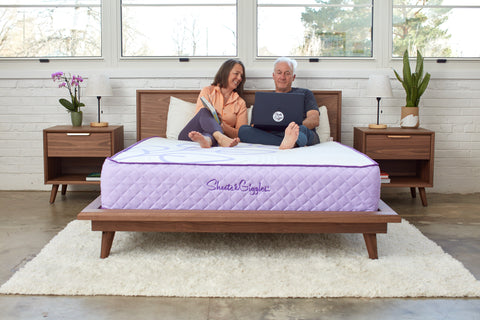Dunlop Latex vs. Talalay Latex
If you’ve found yourself plagued by questions about how latex is processed (and, c’mon, who can say they haven’t?), we’ve got you. You can let out that deep breath you’ve been holding in.
We’re breaking down the two main ways to process latex: Dunlop and Talalay.
In case anyone needs a recap, latex is a material made from rubber that has tons of uses, from paint to gloves to mattresses.

Pictured: one of the many Latex applications (and our personal favorite)
Here’s everything you need to know about how it’s processed:
Dunlop Latex
If you want to make a latex foam the original way, that’s the Dunlop processing method. It starts with liquid latex extract. From there, the manufacturer whips the liquid latex into a foam which then gets poured into a mold.
It’s kinda like a latex version of one of those jello salads from the 80s. Funny enough, they’re equally edible (just kidding, please don't eat latex...or jello salads, for that matter).
Once in the mold, the latex gets baked in a vulcanization oven. And no, unfortunately, that doesn’t have anything to do with Star Trek. Easy mistake to make.
The baking process sets the latex so it can come out of the mold in one piece. Next, it gets thoroughly washed to get rid of soap or other extra materials. The final step in the Dunlop process is to bake it at a high temperature again. If done correctly, the finished product won’t have any excess moisture.
Talalay Latex
The Talalay latex process was developed after the Dunlop process and is slightly more complicated. Like the Dunlop process, though, it starts with whipping liquid latex extract into a foam.
This foam gets injected into a mold, but only enough to partially fill the mold. The manufacturer will then vacuum-seal the mold and this is when the magic happens. Are you ready?

Can hardly stand the anticipation...!
The vacuum seal on the mold causes the latex to expand and fill the remaining space. Once the latex fully expands, the manufacturer uses carbon dioxide to rapidly cool the latex. It freezes in place, ready to get baked to set completely.
Note: no drugs necessary to make Talalay latex. “Getting baked” is totally optional for everyone involved, except the latex.
Finally, the manufacturer removes the latex from the mold and washes and dries it, just like with Dunlop latex.
What’s the Difference?
Now, you may be wondering: OK, so there are two different methods to process latex, so what? And to that, we say, well, a lot. Those are our favorite kinds of questions, honestly.
The differences in the production processes produce two distinct types of latex. Dunlop latex tends to be more dense and firm. So if a more firm mattress is your thing, Dunlop may be the way to go. Just note that because of the ways it settles, there’s more material at the bottom of Dunlop latex than the top, so it ends up being “bottom-heavy.”
Talalay latex is more even throughout. It’s softer, lighter, and more breathable than Dunlop latex, too. Those are just some of the reasons why we chose Talalay latex for our new eucalyptus mattress.
So yes, we’re biased, but our verdict is in favor of Talalay latex. Both latex processing methods are great, it’s just that Talalay is a better mattress material, in our humble opinion.
Try the new Sheets & Giggles mattress to discover the wonders of Talalay latex for yourself.

Join the ranks of the Talalay lovers! We need a club vice president...

